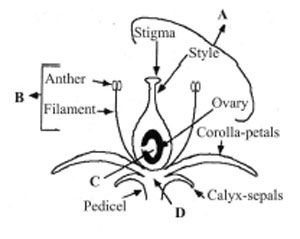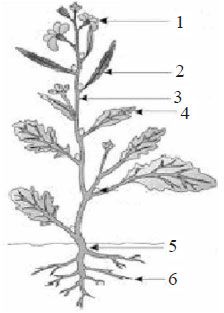Which of the following groups of plants have underground stems?
Potato, ginger, turmeric, Euphorbia, zaminkand
Potato, ginger, turmeric, zaminkand, Colocasia
Potato, Citrus, Opuntia, zaminkand, Colocasia
Potato, cucumber, watermelon, zaminkand, Colocasia
Correct Answer :
B. Potato, ginger, turmeric, zaminkand, Colocasia
Underground stems are non green stems that may take part in perennation, store food or help in vegetative propagation. Underground stems of potato, ginger, turmeric, zaminkand, Colocasia are modified stem to store food in them.
Related Questions
Which of the following is not the characteristic features of fabaceae?
Tap root system, compound leaves and raceme inflorescence.
Flowers actinomorphic, twisted aestivation and gamopetalous.
Stamens 10, introrse, basifixed, dithecous.
Monocarpellary, ovary superior and bent stigma.
Which of the following statement(s) is/are correct about the fruit?
- Fruit is a mature or ripened ovary, developed before fertilization.
- It consists of a wall or pericarp and seeds.
- When pericarp is thick and fleshy, it is differentiated into outer mesocarp, middle epicarp and the inner endocarp.
- In mango and coconut, the fruit is known as a berry.
Only (i)
Both (ii) and (iii)
Only (ii)
All of these
Which one of the following option shows the correct labelling of the structure marked as A, B, C & D?

A - Gynoecium, B - Megasporophyll, C - Ovule, D - Thalamus
A - Gynoecium, B - Stamen, C - Seed, D - Thalamus
A - Microsporophyll, B - Stamen, C - Ovule, D - Thalamus
A - Gynoecium, B - Stamen, C - Ovule, D - Thalamus
When a flower can be divided into two equal radial halves in any radial plane passing through the centre, it is known as
actinomorphic
zygomorphic
asymmetric
bisymmetric
Cotyledons and testa respectively are edible parts in which of the following group?
walnut and tamarind
cashew nut and litchi
french bean and coconut
groundnut and pomegranate
Which of the following option shows the correct labelling of the parts of leaf marked as A, B, C and D.

A - Lamina, B - Axillary bud, C - Stipule, D - Leaf base
A - Lamina, B - Stipule, C - Axillary bud, D - Leaf base
A - Lamina, B - Axillary bud, C - Stipule, D - Pedicel
A - Leaflet, B - Axillary bud, C - Stipule, D - Leaf base
In flower (X), the gynoecium occupies the highest position while the other parts are situated below it. The ovary in such flowers is said to be Y. Identify X and Y and select the correct option.
X - Epigynous, Y - Inferior
X - Perigynous, Y - Superior
X - Hypogynous, Y - Superior
X - Perigynous, Y - Half-inferior
Fibrous root system is found in
monocotyledonous plants.
dicotyledonous plants.
bryophytes.
gymnosperms.
The given figure shows the parts of mango and coconut. Choose the option which shows the correct labelling of A, B, C and D marked in the figures.

A - Epicarp, B - Mesocarp, C - Seed, D - Endocarp
A - Epicarp, B - Mesocarp, C - Ovule, D - Endocarp
A - Epicarp, B - Mesocarp, C - Ovary, D - Endocarp
A - Epicarp, B - Mesocarp, C - Embryo, D - Endocarp
Consider the following statements regarding the root system of angiosperms and choose the correct option given below.
- In monocots, the fibrous root system arises from the base of the stem.
- The region of elongation is called the root hair region.
- In sweet potato, the adventitious roots get swollen and store food.
- The stems of maize and sugarcane have supporting roots called prop roots.
(i) and (ii) are correct but (iii) and (iv) are wrong.
(ii) and (iii) are correct but (i) and (iv) are wrong.
(ii) and (iv) are correct but (i) and (iii) are wrong.
(i) and (iii) are correct but (ii) and (iv) are wrong.
The given figure shows a typical structure of monocotyledonous seeds. Identify A, B, C, D and E parts marked in the given figures.

A - Endosperm, B - Embryo, C - Scutellum, D - Coleorhiza, E - Coleoptile
A- Embryo, B - Endosperm, C - Scutellum, D - Coleoptile, E - Coleorhiza
A - Endosperm, B - Embryo, C - Scutellum, D - Coleoptile, E - Coleorhiza
A - Embryo, B - Endosperm, C - Scutellum, D - Coleorhiza, E - Coleoptile
In which of the following plants, a slender lateral branch arises from the base of the main axis and after growing aerially arch downwards to touch the ground?
Mint and jasmine
Banana and pineapple
Grass and stawberry
Pistia and Eichhornia
Most prominent function of inflorescence is
dispersal of seeds.
formation of more fruits.
formation of pollen grains.
dispersal of pollens.
The given figure shows the parts of flowering plant. Which parts of the given figure were involved in the following functions:
- Storing reserve food material
- Synthesis of plant growth regulators.
- Absorption of water and minerals from the soil.
- Providing a proper anchorage to the plant parts

5 and 6
1, 2 and 6
1, 2, 3 and 4
2, 4, 5 and 6
Which of the following statement(s) is/are correct about venation?
(i) The arrangement of veins and the veinlets in the lamina of leaf is called venation.
(ii) Reticulate venation is the characteristic of monocots.
(iii) When the veinlets form a network, the venation is termed as reticulate venation.
(iv) When the veins run parallel to each other, within a lamina, the venation is termed as parallel venation.
Only (i)
Both (i) and (ii)
(i), (iii) and (iv)
All of these
Statement-1 : Ginger has a prostrate-growing rhizome.
Statement-2 : Shoot growth is not effected by gravity.
Statement-1 and statement-2 are true and Statement-2 is a correct explanation for statement-1.
Statement-1 and statement-2 are true but statement-2 is a correct explanation for statement-1.
Statement-1 is true and statement-2 is false.
Both the statements are false.
Study the following statements and select the correct option
- Buds are present in axil of leaflets of the compound leaf.
- Pulvinus leaf-base is present in some leguminous plants.
- In Alstonia, the petioles expand, become green and synthesize food.
- Opposite phyllotaxy is seen in guava.
(ii) and (iv) are correct but (i) and (iii) are incorrect.
(i) and (iii) are correct but (ii) and (iv) are incorrect.
(i) and (iv) are correct but (ii) and (iii) are incorrect.
(ii), (iii) and (iv) are correct but (i) is incorrect.
Stilt roots occur in __________ .
groundnut
rice
sugarcane
wheat
Given figures (A, B and C) shows the position of floral parts on thalamus. (given as I, II and III) Select the correct combination.

- Hypogynous flower
- Perigynous flower
- Epigynous flower
A-I, B-II, C-III
A-I, B-III, C-II
A-III, B-II, C-I
A-III, B-I, C-II
Which of the following is the green expanded part of leaf with vein and veinlets?
Petiole
Node
Stipule
Lamina
Match the following placentation types given in column I with their examples given in column II and choose the correct combination from the options given below.
| (Placentation Types) | (Examples) |
|---|---|
| A. Basal | I. Dianthus |
| B. Free central | II. Pea |
| C. Parietal | III. Lemon |
| D. Axile | IV. Marigold |
| E. Marginal | V. Argemone |
A I, B II, C III, D IV, E V
A II, B III, C IV, D V, E I
A IV, B I, C V, D III, E II
A IV, B III, C V, D I, E II
The given figure (A, B, and C) shows different types of roots. Identify the root which is seen in wheat plant and originate from the base of the stem?

A
B
C
Both A and B
Match the following stem modifications given in column I with their examples given in column II and select the correct combination from the options given below.
| (Stem Modifications) | (Found in) |
|---|---|
| A. Underground stem | I. Euphorbia |
| B. Stem tendril | II. Opuntia |
| C. Stem thorns | III. Potato |
| D. Flattened stem | IV. Citrus |
| E. Fleshy cylindrical stem | V. Cucumber |
A I, B II, C III, D V, E IV
A II, B III, C IV, D V, E I
A III, B IV, C V, D I, E II
A III, B V, C IV, D II, E I
When a flower has both androecium and gynoecium, it is known as__________.
asexual
bisexual
unisexual
multisexual
A - Which one of the option shows the correct labelling of the parts marked as A, B, C and D in a typical structure of dicotyledonous seeds ?

A - Hilum, B - Micropyle, C - Radicle, D - Cotyledon, E - Plumule
A - Hilum, B - Micropyle, C - Plumule, D - Cotyledon, E - Radicle
A - Micropyle, B - Hilum, C - Plumule, D - Cotyledon, E - Radicle
A - Hilum, B - Micropyle, C - Plumule, D - Radicle, E - Cotyledon
Match the column-I containing types of aestivation with their examples given in column-II and choose the correct option.
| Column - I | Column-II |
|---|---|
| (Type of aestivation) | (Examples) |
| A. Valvate | I. Cotton |
| B. Twisted | II. Calotropis |
| C. Imbricate | III. Bean |
| D. Vexillary | IV. Gulmohar |
A I; B II; C IV; D III
A II; B I; C IV; D III
A II; B IV; C I; D III
A II; B I; C III; D IV
Which one of the following characteristics is not related to gynoecium?
It is the female reproductive part of the flower.
It is composed of stamens.
Stigma is usually at the tip of the style and is the receptive surface for pollen grains.
Each ovary bears one or more ovules attached to a flattened, cushion like placenta.
During the post-fertilization period, the ovules develops into ___A____ and the ovary matures into a ___B ____.
A - seeds; B - fruit
A - fruit; B - seeds
A - flower; B - seed
A - seeds; B - flower
Seeds are regarded as products of sexual reproduction because they
can be stored for long time.
are result of fusion of pollen tube.
are result of fusion of gametes.
give rise to new plants.
Match column I with column II and choose the correct option.
| Column-I | Column-II |
|---|---|
| A. Bud in the | I. Pitcher plant axil of leaf and venus fly trap |
| B. Outer layer of | II. Cacti seed coat |
| C. Spines | III. Testa (modified leaves) |
| D. Leaves modified | IV. Simple leaf to catch insects |
| E. Fleshy leaves | V. Garlic and onion with stored food |
A I, B II, C III, D IV, E V
A V, B IV, C III, D II, E I
A IV, B III, C II, D I, E V
A IV, B II, C III, D I, E V
